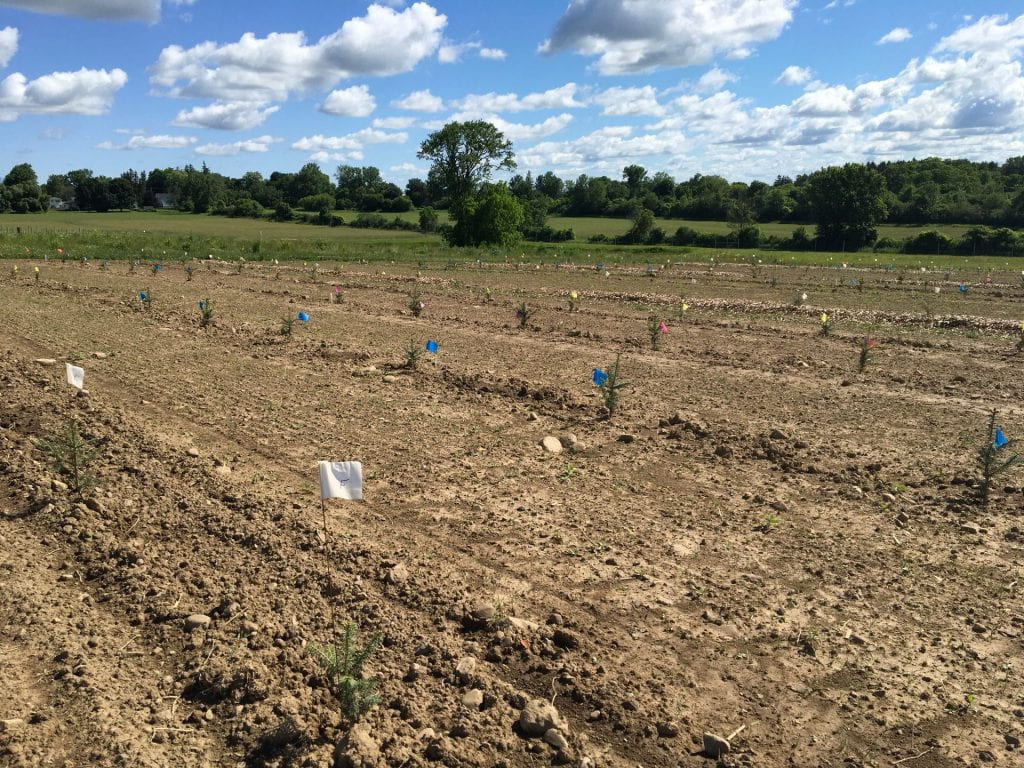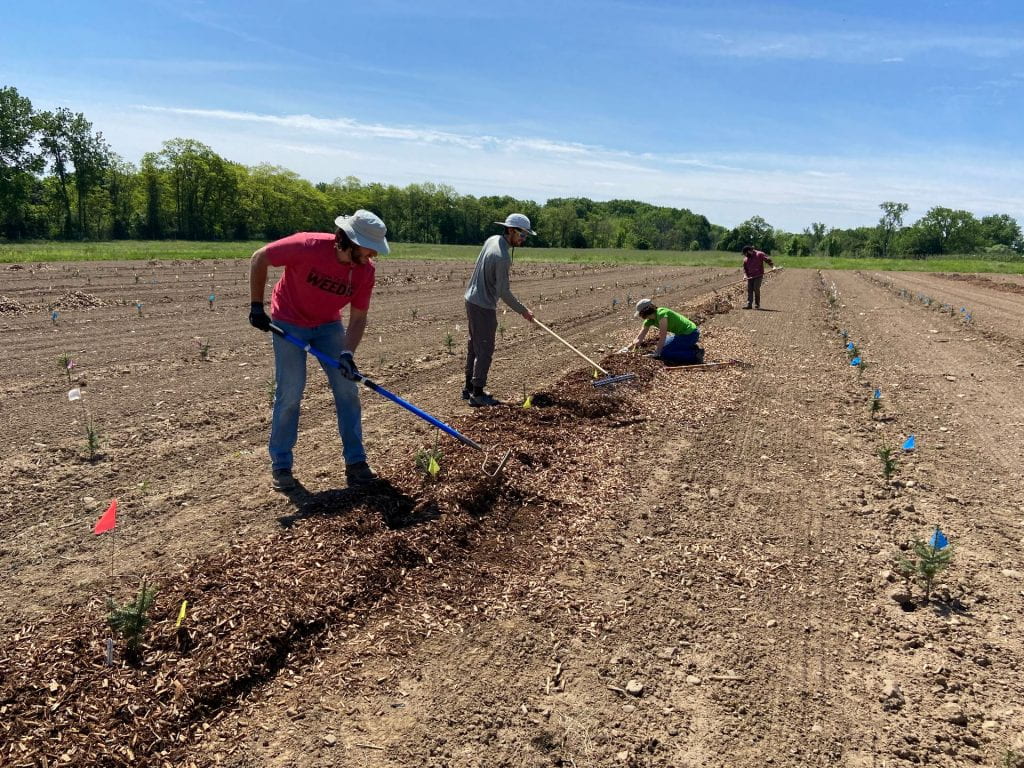
If you’ve been following this blog for a bit, you might recall that the beneficial insect habitat plots I’ve been helping to establish and monitor with my colleagues Betsy Lamb and Brian Eshenaur are located on the edges of a field of Christmas trees. Once the trees get a bit bigger, we’ll be able to start assessing whether trees closer to these wildflowers have fewer pests or not.
New in 2021, I’m collaborating with Bryan Brown, Brian Eshenaur, Betsy Lamb, and Lynn Sosnoskie on a three-year project funded by the USDA to look at IPM when you’re establishing a new field of Christmas trees. An important part of IPM is the integration of multiple strategies when managing pests. So in this project we’re looking at some tools for managing both weeds and root diseases (specifically Phytophthora).
Weeds
Our weed management strategies include:
- Mulching with approximately 3 inches of chipped shrub willow
- Cultivating three times early in the season using a KULT Kress Argus Toolbar with rear side-shift adjustment pulled by a tractor
- Mowing grass seeded around the trees
- Conventional herbicides (oxyfluorfen and pendimethalin applied shortly after planting, with the possibility of additional applications depending on the length of the residual control) as a control treatment
- No weed management at all (another control treatment)
We planted 560 Fraser firs in 20 rows on May 19th, and four of these rows will be receiving each of these different weed management treatments. So far, we’ve spread mulch…

…and applied herbicides.

Lynn and her team collected soil from the field to assess which weed seeds are currently present in the seedbank. They will continue to evaluate the weed seedbank yearly to determine whether different weed management programs result in different weed seeds in the seedbank. Bryan, Lynn, and technicians working for them will also be assessing the success of each weed control strategy throughout the season (weed density and biomass).
Disease
Within each row, plots of seven trees have been assigned to one of four different treatments for root disease control. The biocontrol piece of this project is the root disease management tools. The biofungicide RootShield PLUS WP contains two different species of the fungus Trichoderma. These fungi may protect the trees by:
- Inducing resistance – turning on the plants defense mechanisms ahead of pathogen attack
- Exclusion – growing on the roots so there’s no space for the pathogen to grow
- “Eating” the pathogen – Trichoderma is a fungus that parasitizes other fungi (and water molds)
- Poisoning the pathogen – Trichoderma produces antimicrobial compounds
- Promoting plant growth – Stronger, healthier trees are more likely to survive pathogen attack (and probably be more resilient to water stress).
A study done in Oregon on Douglas fir found that Trichoderma species might help improve survival of trees in pots when they are being attacked by the water mold Pythium. So we’re curious if we can document similar results in the field. We applied RootShield PLUS as a soil drench immediately after transplanting, and will repeat the application 6-8 weeks later.
There’s also been some work done by Richard Cowles in Connecticut suggesting that ProPhyt could improve the color of Fraser firs when they are planted in a field known to have Phytophthora. The active ingredient in ProPhyt is potassium phosphite (equivalent to phosphorous acid), so this product is also classified as a biopesticide by the EPA. I think of it as not really a biological control, since it neither contains a (current or formerly) living organism, nor was made by a living organism. We applied ProPhyt as a root dip immediately before planting. It works by inducing plant resistance, and also inhibiting (“poisoning”) water molds like Phytophthora.
The other two root disease treatments are controls: Subdue Maxx (active ingredient mefenoxam) and just water. Subdue Maxx was applied as a shielded, soil-directed spray the day after we transplanted the trees. All the trees were watered in right after planting because we planted a bit late in the season and it was a pretty warm day. The label calls for a second application in the fall.
So far, we’ve collected data on the initial height, stem diameter (4 inches above the soil) and needle color of every tree in the field. We’ll do this again in the fall to assess tree growth over this first season, and tree health (needle color). We will also record how many trees in each treatment survive. Bi-weekly weed surveys have also been initiated. Bryan has started cultivating the trees in that weed control treatment.
Video of Christmas tree cultivation
For updates on this project, you can check back on this blog (subscribe so you’ll know when new posts are available), follow Lynn and Amara on Twitter or on Instagram (@specialtycropweedscience and @biocontrol.nysipm), or listen to Bryan’s podcast. We’ll also be hosting events at the field (Geneva, NY) in this and subsequent years (put August 19th on your calendars, and stay tuned for more details), and hope to provide updates at future Christmas Tree Farmers Association of NY meetings.
 This work is supported by Agriculture and Food Research Initiative – Foundational and Applied Science Grant no. 2021-68008-34179/project accession no. 1025660 from the USDA National Institute of Food and Agriculture.
This work is supported by Agriculture and Food Research Initiative – Foundational and Applied Science Grant no. 2021-68008-34179/project accession no. 1025660 from the USDA National Institute of Food and Agriculture.
This post was written by Amara Dunn, Biocontrol Specialist with the NYSIPM program. All images are hers, unless otherwise noted.
